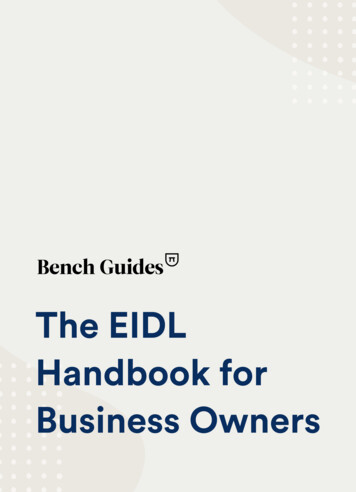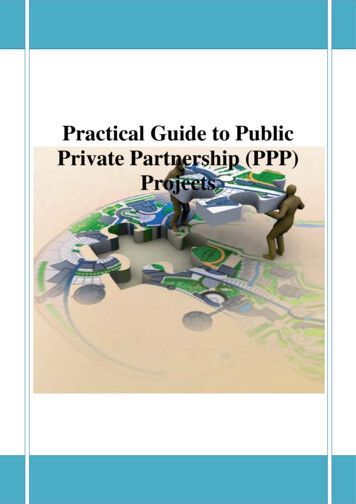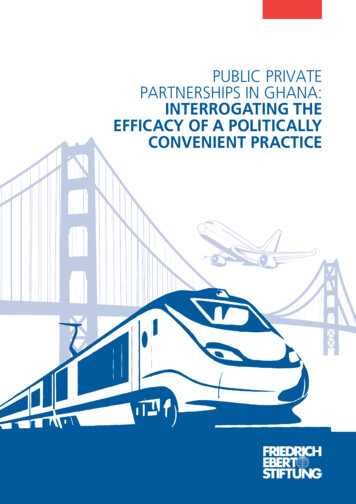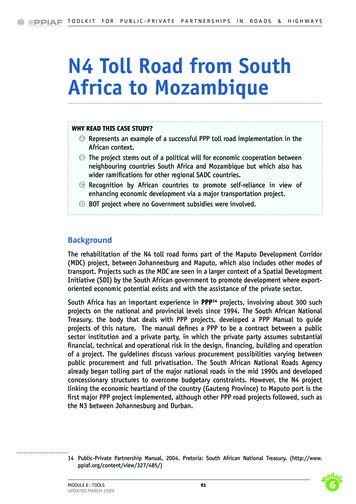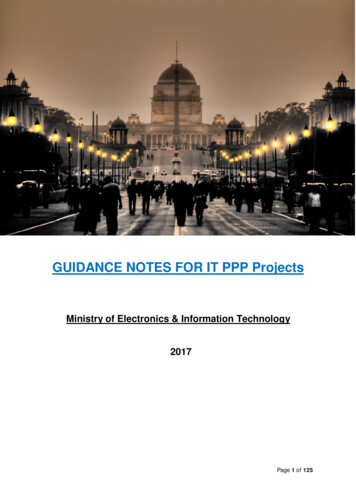
Transcription
Guidance Notes : Model RFP Templates for Public Private PartnershipIskGUIDANCE NOTES FOR IT PPP ProjectsMinistry of Electronics & Information Technology2017Page 1 of 125
Guidance Notes : Model RFP Templates for Public Private PartnershipThis document is advisory in nature and aim to sensitize the bid management teams on goodpractices and harmonize/standardize the RFP clauses and terms & conditions.All the part of documents “Model RFP Templates for Public Private Partnerships and Guidance Notesfor preparation of RFPs for E–Governance Projects” are based on existing Central GovernmentGuidelines, feedback from stakeholders and prevalent international practices. However it is possiblethat the State Government / Nodal Agencies may have their own specific procurement Guidelineswhich may or may not be consistent with the clauses of the RFP, Guidance notes or ContractAgreement.It may be noted that these documents do not substitute or overrule any approvals currently requiredby the concerned Department/State Government Nodal Agency for finalization of the RFP.Accordingly it is advised that all necessary approvals are taken from appropriate authorities, as donebefore publication of these model documents.Page 2 of 125
Guidance Notes : Model RFP Templates for Public Private PartnershipGlossary1.BLTBuild Lease Transfer2.BOOBuild Own Operate3.BOOTBuild Own Operate Transfer4.BOTBuild Operate Transfer5.C&AGComptroller & Auditor General, Government of India6.CVCCentral Vigilance Commission7.DEADepartment of Economic Affairs8.DFIDDepartment for International Development9.MeitYMinistry of Electronics & Information Technology, Government of India10.EOIExpression of Interest11.FIRRFinancial Internal Rate of Return12.GFRGeneral Financial Rules, 201713.GoIGovernment of India14.ICBInternational Competitive Bidding15.ICTInformation and Communication Technology16.KPIKey Performance Indicator17.LROTLease Renovate Operate and Transfer (model under PPP )18.MMPMission Mode Project19.NeGPNational e-Governance Plan20.NPVNet Present Value21.NICSINational Informatics Centre Services Inc.22.O&MOperations and Maintenance23.OPOutright purchase24.OPEOut-of-pocket expenses25.OPPOriginal Project Proponent26.PFIPrivate Fund InitiativePage 3 of 125
Guidance Notes : Model RFP Templates for Public Private Partnership27.PPPPublic Private Partnerships28.QCBSQuality Cum Cost Base Selection29.ROEReturn on Equity30.RFERequest for Empanelment31.RFPRequest for Proposal32.SOWScope of Work33.SLAService Level Agreement34.SPV/CSpecial Purpose Vehicle/Company35.TCOTotal Cost of Ownership36.T&MTime and Material37.VFMValue for MoneyPage 4 of 125
Guidance Notes : Model RFP Templates for Public Private PartnershipTerms used for this DocumentTermsMeaningNodal AgencyThe nodal agency which is responsible for executing the projectand assists the Department in carrying out the Bidding. Also this isknown as State Designated Agency. In case the Governmentdepartment itself decides to carry out the Bidding and executethe project, then the term “Nodal Agency” should be replaced bythe Department.The Department is the ultimate “owner” of the project. The eGovernance is carried out within the domain of the department.Department orAuthorityPrivate Vendoror Agency orPartner(Optional)The Vendor who is bidding or the Vendor who has been Selectedpost the bid process, depending on the context of usage in thisDocumentCertain clauses are optional to be put in the document and woulddepend on certain conditions. These may be included in the RFP,post establishing the relevance of the clause.Page 5 of 125
Guidance Notes : Model RFP Templates for Public Private PartnershipKey Highlights / Changes Introduced1 Preparation forestablishing the feasibilityof a e-Governance PPPproject2 Eco-System for managingthe PPP Project3 Balanced Sharing of Risks4 Eligibility and TechnicalEvaluation5 Promote Transparency ofInformation6 Standardization / Clarity7 Focus on Outcomes8 Rational approach todrafting of Service LevelAgreements9 Updated Some of the KeyClauses10 Promoted Small andMedium Enterprises Provided for enough pre-Tender planningand establishing financial and economicfeasibility of the project Defining roles of various entities for ensuringproper check and balances for creating asuccessful PPP project Identification of risks and allocating it to theparty best positioned to handle that risk Rationalized the criterions in the Eligibility /Prequalification and the Technical evaluation(eliminated restrictive criterions) Standards in the quality of information to beprovided in the RFP document Upfront sharing of Project Budgetinformation Recommendations on Performance andOutput specifications Choice of PPP Model Risk Allocation Matrix Payment Schedule linked to theoutcomes/Transactions Aligned as per International practices &procedures for establishing a baseline,service credits and earn-backs Debarment from bidding Conflict of interest Clarifications Request/Appeal Post TechnicalEvaluation Allocation of % on Contract Value Evaluation Score assignedPage 6 of 125
Guidance Notes : Model RFP Templates for Public Private PartnershipCross Utility of this documentWhile this document has been developed for PPP contracts, it has been structuredto manage large and complex projects involved in e-Governance Service Delivery.Since these projects are long duration projects, there are a lot of risks involvingdemand (number of transactions), Design, Maintenance, Technology, Inflation etc.It has been observed that in case the Government tries to pass-on these risks to theprivate sector during the procurement process, it has an adverse affect of thechances of success. This standard document (including contract agreement) focuseson a partnerships approach where the risk is shared between the Government andprivate partner in the e-Governance journey.Hence to that extent this Model RFP can be used for large, complex and longduration projects (more than 7 years) involving service delivery. Also this templatecan also be used for taking over a live project after the completion of the contractperiod of the incumbent vendor (i.e. less of development work and more ofOperations and Maintenance work).Page 7 of 125
Guidance Notes : Model RFP Templates for Public Private PartnershipTable of ContentsPRE – BID PROCESS: PPP PROJECT ASSESSMENT . 111INTRODUCTION . 131.11.21.31.41.52RELEVANCE OF PPP IN E-GOVERNANCE . 162.12.22.32.42.52.62.72.82.93WIN-WIN PROPOSITION . 16KEY ELEMENTS OF PPP IN E-GOVERNANCE . 16CHARACTERISTICS OF PPPS IN E-GOVERNANCE . 17OBJECTIVES OF PPPS IN E-GOVERNANCE . 18COMPLEXITIES IN PPPS . 18WHEN SHOULD PPP BE CONSIDERED? . 19PPP IN E-GOVERNANCE: LACK OF RESOUNDING SUCCESSFUL CASE STUDY . 22RISKS IDENTIFICATION AND ALLOCATION – CRITICAL FOCUS OF PPP DESIGNING . 22MAJOR POLITICAL CONSTRAINTS AND CHALLENGES TO PPP . 29PPP MODELS AND THEIR VARIANTS . 313.13.23.33.44BACKGROUND . 13PPP MODE OF PROCUREMENT FOR E-GOVERNANCE PROJECTS . 13DEFINITION OF PPPS IN INDIA . 13EXTANT POLICY GUIDELINES ON PPPS . 14OBJECTIVES AND SCOPE . 15PROJECT CHARACTERISTICS AFFECTING CHOICE OF PPP MODE . 31PPP MODELS . 33WHICH MODEL TO SELECT? . 37PPP SUPPORTING ENVIRONMENT . 38OVERVIEW OF THE PPP PROCESS. 464.14.2IDENTIFY AND STRUCTURE FEASIBLE PPP PROJECTS . 46FINANCIAL ASSESSMENT OF PPP PROJECTS . 48TIPS FOR BID PROCESS FOR PPP PROJECTS . 525CHOOSING THE BEST-SUITED PROCUREMENT METHOD . 535.15.25.36PROCUREMENT STRATEGIES . 53GENERIC PROCUREMENT STRATEGIES . 53DESIGN OF THE PROCUREMENT PROCESS. 56DESIGNING SERVICE PERFORMANCE SPECIFICATIONS . 626.16.26.36.46.5SEVERITY WEIGHTS . 62SERVICE LEVEL CHANGES . 62SERVICE LEVEL CLASSIFICATIONS. 63SERVICE LEVEL FAILURES . 63SERVICE LEVELS – ESTABLISHMENT AND VALIDATION . 63Page 8 of 125
Guidance Notes : Model RFP Templates for Public Private Partnership6.66.76.86.96.106.116.126.13CALCULATING PENALTIES AS SERVICE CREDITS . 72EARN-BACKS . 73UNACCEPTABLE SERVICE . 73CONTINUOUS IMPROVEMENT . 74GENERAL PROVISIONS . 74ESCROW AGREEMENT. 75RESALE OF NETWORK BANDWIDTH . 76ILLUSTRATIVE TEMPLATE FOR SLA . 767FIRST DRAFT OF KEY PROJECT DOCUMENTS . 978APPROVALS: PROCESS FOR IN-PRINCIPLE CLEARANCE. 998.18.28.38.49BID PREPARATION: EOI AND RFP PROCESS. 1029.19.29.39.49.510PREPARING FOR PROCUREMENT . 99FORMING A PROCUREMENT AND EVALUATION TEAM . 99REVIEWING AND UPDATING PROJECT INFORMATION . 100APPOINTING AN INDEPENDENT MONITOR . 101EOI PROCESS . 102RFP & CONTRACT DESIGN . 102READINESS CHECK AND FINAL APPROVAL . 103APPLICATION FOR FINAL APPROVAL . 105BIDDING - RFP AND BID EVALUATION . 105BEST PRACTICES IN BIDDING, EVALUATING, AND NEGOTIATING PPP TRANSACTIONS . 10610.1.1.111Preference to domestically manufactured electronic products in Government procurement (PMA). 108PUBLIC DISCLOSERS AND AUDIT REQUIREMENTS. 11111.111.211.311.4PUBLIC DISCLOSURE OF THE PPP AGREEMENT . 111APPROACH TO PUBLICATION . 112PRESERVING COMMERCIAL CONFIDENTIALITY . 112AUDITING OF PPP PROJECTS . 113APPENDIX . 114Page 9 of 125
Guidance Notes : Model RFP Templates for Public Private PartnershipNeed for standardization of RFPs for PPP projectsNeed for a standardized frameworkWith a view to enabling a smooth transition from Government projects to Public PrivatePartnerships (PPPs) and for adoption of best practices, DIT(GoI) has recognized the critical role ofstandardizing documents and processes to be adopted for structuring and award of PPP contracts.Standardized documents enable project authorities to save on the time and costs involved instructuring and awarding complex e-Governance PPP projects. In addition, they afford protection toindividual entities and officials against making errors and answering for them. Such standarddocuments typically lay down the norms, principles and parameters to be followed for PPP projectsand enable project authorities to adopt them with considerable ease for meeting the specificrequirements of individual projects.One of the key factors for the success of a PPP contract is the transparency of the selection process.A fair and competitive selection of the private partner is of utmost importance in the entire processsince cost and quality of service to users would depend on the performance of the private partner.In line with this objective, guidelines have been framed for the Request for Proposal (RFP) stageinvolving submission of financial bids subsequent to a process of pre-qualification at the Expressionof Interest (EOI) stage.The guidelines are broad and generic in nature and aim at lending transparency and predictability tothe entire process, allowing decisions to be made objectively and expeditiously. They address thecritical minimum requirements that must be observed in conducting a credible selection process.It is expected that the concerned Departments & State’s Nodal Agencies intending to procure PPPprojects would adopt this document while conducting the bidding process for e-Governance PPPprojects. It allows sufficient flexibility for incorporating project specific requirements withoutcompromising on the underlying principles. The salient features of the guidelines are as follows:Two-stage processThe bidding process for PPP projects is divided into two stages. The first stage is generally referred toas Expression of Interest (EoI). The objective is to pre-qualify and short-list eligible bidders for stagetwo of the process. These have been provided in Section 1 : Guidance Notes : Model RFP Templatesfor Implementation Agencies. These should be used before the second and final stage, which isgenerally referred to as the Request for Proposal (RFP) or invitation of financial bids, the biddersengage in a comprehensive scrutiny of the project before submitting their financial offers.ConclusionA Model RFP document has been developed based on the principles outlined above. It is generic innature and aims at lending transparency, efficiency and predictability to the entire process, allowingdecisions to be made objectively and expeditiously. It also provides the requisite sector-specific andproject-specific flexibility by placing several provisions within square brackets, thus enabling theNodal Agencies to make necessary substitutions.Page 10 of 125
Guidance Notes : Model RFP Templates for Public Private PartnershipPRE – BID PROCESS: PPP PROJECT ASSESSMENTPage 11 of 125
Guidance Notes : Model RFP Templates for Public Private PartnershipThis page has been intentionally left blank.Page 12 of 125
Guidance Notes : Model RFP Templates for Public Private Partnership1 Introduction1.1 BackgroundIn the past few years, e-Governance has gained considerable momentum in India, with severalstrategic e-Governance initiatives of the Government of India and the State Governments beingexecuted in partnership with the Information Technology (IT) industry. The National e GovernancePlan (NeGP), which was approved in May, 2006 and comprises of 27 Mission Mode Projects (MMPs)and 10 components, seeks to improve delivery of Government services to citizens and businesseswith the following Vision:“Make all Government services accessible to the common man in his locality, through commonservice delivery outlets and ensure efficiency, transparency & reliability of such services at affordablecosts to realize the basic needs of the common man”For major projects like Bharat Nirman, Rural Employment Guarantee Schemes etc., the lineministries have been advised to make use of e-Governance as also automation techniques from theinception stage. States have also been given the flexibility to identify additional state-specificprojects, relevant to the economic development of the State.Accordingly, the focus of e-Governance projects is now more on outcomes and service deliveryrather than being IT hardware-centric.1.2 PPP Mode of Procurement for E-Governance ProjectsRecognizing the private sector capacities in India in providing IT services, the Government of Indiarecognizes that a partnership approach under the Public Private Partnership (PPP) should be one ofthe modes of procurement, wherever feasible, for obtaining e-Governance solutions, withoutcompromising on the security aspects.As per Ministry of Finance, Department of Economic Affairs, (Infrastructure Section) PPP is formallydefined projects, as “a project based on a contract or Contract Agreement (PPP), between aGovernment or statutory entity on the one side and a private sector company on the other side, fordelivering an infrastructure service on payment of user charges”. In a more general context, PPPrefers to a contractual agreement between public and private sector partners, allowing for greaterprivate sector participation than traditional, and involves a different/evolved nature of relationshipbetween the public and private sectors from the traditional arms-length to one based on trust.1.3 Definition of PPPs in IndiaThe Department of Economic Affairs (DEA) defines PPPs as:Page 13 of 125
Guidance Notes : Model RFP Templates for Public Private PartnershipPPP means an arrangement between a government or statutory entity or government owned entityon one side and a private sector entity on the other, for the provision of public assets and/ or relatedservices for public benefit, through investments being made by and/or management undertaken bythe private sector entity for a specified time period, where there is a substantial risk sharing with theprivate sector and the private sector receives performance linked payments that conform (or arebenchmarked) to specified, pre-determined and measurable performance standards.1.4 Extant Policy Guidelines on PPPsThe Ministry of Finance (Department of Economic Affairs) have prescribed broad guidelines of theGovernment of India, for Formulation, Appraisal and Approval of Central Sector Public PrivatePartnership (PPP) Projects1. The only exceptions to these guidelines are the Ministry of Defence, andthe Departments of Atomic Energy and Space. Even though e-Governance cannot be defined as an“infrastructure service”2 , these guidelines serve an important best practices for successfulimplementation of e-Governance Projects in India.The best practices include several infrastructure sector specific policy guidelines3 and toolkits issuedby the Government of India. The Comptroller and Auditor General of India (C&AG)4 have also issuedguidelines for audit of PPP projects.The difference between physical infrastructure projects is thata) These projects are capital intensive, generally use conventional technology and are notsignificantly impacted by issues of technological obsolescence, strategic control,interoperability, change management and exit management.b) Against this position, e-Governance projects are highly technology and intellectual capitalintensive and are majorly impacted by technological obsolescence, strategic control,interoperability issues, change management and exit management.c) Primary policy objective of PPPs in the infrastructure space where investment requirementsare large is to procure substantial investments by the private sector, which is not the casefor e-Governance projects. Hence as e-Governance projects are not “infrastructureprojects”, there is a lack of institutionalized financing for these projects.1Guidelines for Formulation, Appraisal and Approval of Public Private Partnership Projects, Ministry of Finance,Department of Economic Affairs, 2008,http://www.pppinindia.com/pdf/guidelines approval central sector ppp projects english.pdf.2DEA, MoF has defined the Infrastructure services as (i) Roads and bridges, railways, seaports, airports, inland waterways;(ii) Power; (iii) Urban transport, water supply, sewerage, solid waste management and other physical infrastructure inurban areas; (iv) Infrastructure projects in Special Economic Zones; and (v) International convention infrastructure centresand other tourism infrastructure projects.3Ref PPP initiatives of the States at hp4The C&AG guidelines on PPP audit are available udit meth/Public Private Partnerships(PPP) Infrastructure ProjectsPublic Auditing Guidelines-2009/ppp-project.pdfPage 14 of 125
Guidance Notes : Model RFP Templates for Public Private Partnership1.5 Objectives and ScopeThe Guidance detailed in this document are intended for application in respect of PPP projects in eGovernance and seek to augment the aforesaid broad principles and guidelines, in respect of issuesspecific to such projects.These guidance notes can apply to all Central Sector or Centrally Sponsored e-Governance PPPprojects including the MMPs and components under NeGP. For the purposes of this document, “eGovernance shall mean the use of Information and Communications Technology (ICT) at all levels ofthe Government in order to provide services to the citizens, interaction with business enterprisesand communication and exchange of information between different agencies of the Government ina speedy, convenient efficient and transparent manner. Basically, e-Governance is all about reformin governance, facilitated by the creative use of Information and Communications Technology.Business Process Reengineering (BPR) is the key to implementing e-Governance reforms.Page 15 of 125
Guidance Notes : Model RFP Templates for Public Private Partnership2 Relevance of PPP in e-Governance2.1 Win-Win PropositionWhen assessing eGovernance projects for PPP model, one has to ask first: could the private sectorhas the wherewithal required to design and operate an e-governance services? If so, would that bepreferable to the public sector financing and operating the system, thus freeing up public sectorresources for projects that have higher social returns? And second: would the private sector be ableto manage and operate the e-Governance project, under government supervision or regulation,more efficiently than the government? If so, how can the government get the highest number ofcompetitive bids so that PPP’s in e-Governance represent a best value and a technical innovation?In most countries, the rationale to undertake e-Governance are compelling. All levels of governmentrequire modernization, new technologies, better efficiency, and improved services for citizens andcustomers. However, many of the upgrades and modernization required is not only capital intensiveand expensive, but is also complex to manage and outside of the scope and skill-set of mostgovernment agencies. By having the private sector perform an e-Governance or ICT service, onbehalf of, the government, a potential “win-win” solution can be realized where the private sectorfinanced and operates a system, the government is in a better position to “ensure” effective deliveryof the service, and the customer/citizen is receiving a higher quality service and is engaged moreconstructively in customer interfaces with the public sector.2.2 Key Elements of PPP in e-GovernanceIn order for Public-Private Partnerships in e-Governance to be successful, they must be firmly rootedwithin an overall policy framework of reform for the delivery of public services and theadministration of government.On their own, PPPs can help improve the efficiency of a specific public service or governmentaladministrative procedure, but unless PPPs occur within the context of an overall policy frameworkthat supports broader reforms, beyond just improved efficiency in one specific service or procedure,the goals and objectives of PPPs in E-Governance will remain limited.PPPs can realize these objectives best when they are part of an overall policy framework of reform inthe delivery of public services and the management of governmental administrative procedures. Keyelements of these policy frameworks should include: Government ministries that focus on policymaking and planning, but that delegateoperational decision-making to Nodal Agencies, their Boards and their managers;Regulation & performance monitoring of these Nodal agencies and any private serviceproviders (PPPs) that is done by a Nodal Officer from the concernedDepartment/Ministry;Page 16 of 125
Guidance Notes : Model RFP Templates for Public Private Partnership Ownership of the IT infrastructure by a Nodal Agency which is responsible for servicedelivery or contracting with private companies, through PPPs, for the delivery of theseservices;Operation of IT Infrastructure, and the delivery of e-Governance services by privatevendors through transparent, competitively-procured PPPs.PPPs therefore, are one important part of a much broader framework to separate or un-bundle keyroles of governance: planning & policy-making; regulation & performance monitoring; ownership ofassets and contracting for their operations &management, and; the operation and management ofthose services and procedures. Without a dedicate effort to realize these broader policy objectives,PPPs can add processing capacity and delivery capacity, but they will likely be unable to contributesignificantly to improving efficiency, productivity, performance, and quality throughout the sector.2.3 Characteristics of PPPs in E-GovernanceA PPP typically has the following characteristics: The private sector is responsible for carrying out or operating the project and takes on a share of the associatedproject risksDuring the operational life of the project the public sector’s role is to monitor the performance of the privatepartner and enforce the terms of the contractThe private sector’s costs may be recovered in whole or in part from charges related to the use of the servicesprovided by the project, and may be recovered through payments from the public sectorPublic sector payments are based on p
28. QCBS Quality Cum Cost Base Selection 29. ROE Return on Equity 30. RFE Request for Empanelment 31. RFP Request for Proposal 32. SOW Scope of Work 33. SLA Service Level Agreement 34. SPV/C Special Purpose Vehicle/Company 35. TCO Total Cost of Ownership 36. T&M Time and Material 37. VFM Value for Money
